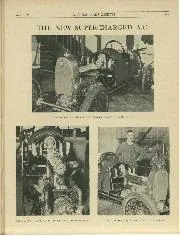
THE NEWS SUPERCHARGED A.C.
THE NEW SUPERCHARGED A.C.
EDITORIAL NOTES.
A Distressing Trend.
AS keen motorists who take a delight in handling a car of lively performance, we view with distaste the increasing number of manufacturers who are pi °clueing vehicles of the plodding type. As we look through makers’ catalogues we experience a momentary sensation of pleasure when we find a model listed with a four-speed gear-box. ” Aha ! ” we say, ” here is a car which will put up a fast average, and which will be a pleasure to drive on twisty and hilly roads.” How unfounded this pleasureable anticipation can be is illustrated so soon as a run is taken in a 1927 4-speed hearse. We recently had the pleasure (?) of a run in one of these cars. Admittedly it was not an expensive car, but why, when four speeds are fitted, should the extra speed be ” attached” at the bottom and where it is never required, except perhaps for restarting on Beggars Roost ! Having the fourth speed at the bottom and, of course, leaves the usual 3-speed compromise gear-box as before, with its low top and 30 m.p.h. third gear—the joy of the man who hates gear changing and who regards his gear-box as a starting
device pure and simple. That this tendency is v recent, we discovered when driving an ancient 11.9 coupe of 1921 vintage, which also had four speeds. Here was a gear-box indeed, with a high top and a useful third, while the other two ratios were amply low enough to enable the engine to haul the somewhat ponderous body up anything.
In spite of the antiquity of the engine and the excessive body, the car was far more lively than the 1927 model. Top was high enough to provide good speed without fuss and rattle, while third gear was invaluable on long, gentle hills and twisty roads. Manufacturers are not really to blame for this state of affairs, which has been brought about by the evergrowing class of non-mechanical and unsympathetic motorist, who merely desires to “have a car” and who is not interested in performance, but who likes to
have four speeds, that he may crow over his three speed neighbour. Study this man’s driving methods : top gear is engaged at 15 m.p.h., and the low geared woolly engine does not mind ; put him in a hot stuff sports car with close ratios, and watch his pitiful mal-treatment of the engine, which he will expect to perform on top as well as his own paralytic waggon, and note his air of horror when you suggest that to experience the full joy of the car at least 50 m.p.h. should be attained on the indirect ratios.
This class is doubtless largely responsible for the demand for the ” small-six” which is in danger of ousting its cheaper and more economical 4-cylinder brother—simply because the six is more smooth running and tractable when driven as a one-speed vehicle.
Let us plead for a generation of keener motorists who enjoy their cars for themselves more than they enjoy the sensation of possessing a car. The former is a real hobby, but the latter is mere neighbourly rivalry.